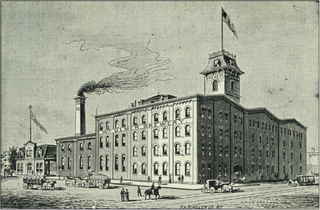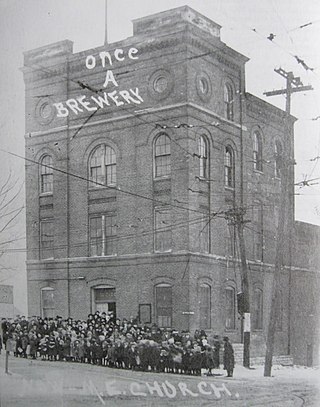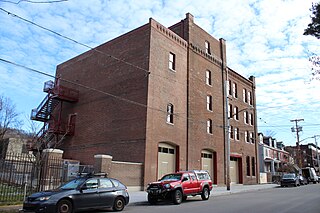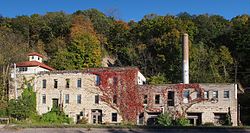
Monument Hill and Kreische Brewery State Historic Sites are two state historic sites managed by the Texas Historical Commission. They are located at 29.888° -96.876°, just off U.S. Route 77, south of La Grange, Texas. The sites sit on a sandstone bluff 200 feet above the Colorado River. Monument Hill is a memorial to the men who died in the Dawson Massacre and in the Black Bean Episode of the ill-fated Mier Expedition.

Fitger's Brewing Company was a beer manufacturer in Duluth, Minnesota, United States, from 1881 to 1972. The surviving brewery complex stretches for 720 feet (220 m) along the Lake Superior shoreline and East Superior Street, one of Duluth's main roads. The majority of the ten-building complex was constructed between 1886 and 1911. Fitger's, as it is now known, has undergone adaptive reuse as an indoor mall with shops, restaurants, nightclubs, a hotel, and a museum on the brewery's history.

This is a list of the National Register of Historic Places listings in Scott County, Minnesota. It is intended to be a complete list of the properties and districts on the National Register of Historic Places in Scott County, Minnesota, United States. The locations of National Register properties and districts for which the latitude and longitude coordinates are included below, may be seen in an online map.

The Strunk–Nyssen House is a historic property in Jackson Township, Minnesota, United States, just outside the city of Shakopee. The original wing of the house was built around 1856 for Herman H. Strunk, who established the area's first brewery on the site. The brewery went by several names over the course of its existence, but is commonly referred to as the Shakopee Brewery. The residence was enlarged around 1880 by Hubert and Mary Nyssen, who used the second floor as a boarding house. The Nyssens continued operating the brewery until 1920.

The New Market Hotel and Store is a historic commercial building in Elko New Market, Minnesota, United States. It was built in 1897 to house a general store at ground level and a small hotel on the second floor. The property was listed on the National Register of Historic Places in 1980 for its significance in the themes of architecture and commerce. It was nominated for being a well-preserved example of the late-19th-century commercial buildings constructed along the main streets of towns in Scott County, Minnesota, and the only surviving example from New Market.

Gunther Brewing Company is a historic brewery industrial building complex, located in the Canton neighborhood of southeast Baltimore, Maryland,. The site comprises 15 masonry buildings. The main structure is a five-story brick L-shaped Romanesque Revival-style brew house with a two-story brick ice plant built about 1910 and one- and two-story boiler room. Additional brew houses built in 1936 and 1950 are also on the property. The later Tulkoff factory and warehouse was built about 1964. It was home to the George Gunther, Jr. Brewing Company, founded in 1900. By 1959, it was the second largest brewery in Baltimore, one of the major centers of brewing in America, when it produced 800,000 barrels per year and employed approximately 600 people. Hamm's Brewing Company bought the Gunther Brewing Company in 1960, and later became part of Miller Brewing Company. The brand was acquired just three years later by the F. & M. Schaefer Brewing Company in 1963, the plant in Canton was closed in 1978. The Tulkoff company briefly used the factory for their sauce products at the conclusion of all brewing operations.

The Calumet and Hecla Industrial District is a historic district located in Calumet, Michigan and roughly bounded by Hecla & Torch Lake Railroad tracks, Calumet Avenue, Mine and Depot Streets. The district contains structures associated with the copper mines worked by the Calumet and Hecla Mining Company, located along a line above the copper lode, where railroad tracks connected separate mine heads. The Historic District is completely contained in the Calumet Historic District and the Keweenaw National Historical Park. It was designated a Michigan State Historic Site in 1973 and was listed on the National Register of Historic Places in 1974.

The Quinnipiac Brewery, also known as Brewery Square, is a complex of brick buildings at 19-23 River Street in the Fair Haven neighborhood of New Haven, Connecticut. Developed beginning in 1892 and operative until the 1930s, the complex is a rare example of a late 19th-century large-scale brewery. The complex was listed on the National Register of Historic Places in 1983. Most of the complex is now residences.
Wild's Mill Complex was among the last remaining industrial buildings in the formerly thriving milling community of Valatie, Columbia County, New York, United States. It was located southeast of the intersection between U.S. Route 9 and State Route 203. A five-story brick structure, it served as an historical landmark and its 5.5 acres (2.2 ha) lot contained the ruins of a previous mill. It was situated along the west bank of the Kinderhook Creek.

The William Ulmer Brewery is a brewery complex in Bushwick, Brooklyn, New York City. It consists of four buildings—an office, a brew house, an engine–machine house, and a stable–storage house—all constructed between 1872 and 1890 in the German round-arch style. The site is bounded by Belvidere Street to the southeast, Beaver Street to the northeast, and Locust Street to the northwest, with the address 31 Belvidere Street. The main brew house, the engine–machine house, and the office building were designed by Brooklyn architect Theobald Engelhardt, while the stable–storage house was designed by Frederick Wunder.

The Neuweiler Brewery, also known as the Germania Brewery, is an historic brewery complex located in Allentown, Pennsylvania. Built between 1911 and 1913, the complex consists of the office building, brew house, stock house, pump house, wash house, chemistry lab building, boiler room, bottling house, garage, fermenting cellar, and smokestack with the name "Neuweiler" on it.

The Highland Spring Brewery Bottling and Storage Buildings, including the Oliver Ditson Company Building, are located at 154-166 Terrace St. in the Mission Hill neighborhood of Boston, Massachusetts. This complex consists of several brick industrial buildings. constructed over time beginning in 1892. The main building, a four-story Romanesque structure at 164 Terrace Street, was built that year by the Highland Spring Brewery. A second, five-story Georgian Revival building was added in 1912; this building was acquired in 1925 by the Oliver Ditson Company, a leading 19th century publisher of sheet music.

Nassau Brewing Company, also known as the Budweiser Brewing Company of Brooklyn and Bedford Brewery, is a historic brewery apartment complex located in the Crown Heights neighborhood of Brooklyn, Kings County, New York. It consists of two remaining industrial buildings dating from the 1860s to the 1880s and are in the Rundbogenstil and Romanesque Revival style. The brick buildings are two to six stories and form an "L"-shape. The buildings feature substantial underground brick vaults originally constructed for the aging of lager beer at near-freezing temperatures. The brewery closed in 1916. The earlier sections are vacant and the 1880s elements were rehabilitated as apartments and offices in the 2000s.

South Bend Brewing Association is a historic brewery complex located at South Bend, St. Joseph County, Indiana. The main plant was built in 1905, and is a large, irregularly shaped brick building with a four-story section. It features square corner towers and a crenellated parapet. A one-story, glass paneled storefront was added in the 1950s. A separate bottling works building was constructed in 1910.

The Escanaba Central Historic District is a commercial historic district located along Ludington Street in Escanaba, Michigan, generally encompassing the 200-1800 blocks. The district was listed on the National Register of Historic Places in 2014.

The Northern Brewery is a former industrial building located at 1327 Jones Drive in Ann Arbor, Michigan. It was listed on the National Register of Historic Places in 1979.

The Flint Brewing Company Building was a former brewery located at 2001 South Saginaw Street in Flint, Michigan. It was listed on the National Register of Historic Places in 1980, and removed from the list in 2020.

The Melchoir Brewery and Hotel Ruins are located at the base of the bluffs along the Mississippi River in Trempealeau, Wisconsin. Built in 1857, the site was added to the National Register of Historic Places in 1984.

The Hazelwood Brewing Company is an historic brewery complex which is located in the Hazelwood neighborhood of Pittsburgh, Pennsylvania.

Schade Brewery, commonly known as Schade Towers, is a historic building in the University District section of the East Central neighborhood of Spokane, Washington. It was built in 1902, with additional construction taking place in 1903, 1907 and between 1934 and 1937. It was added to the National Register of Historic Places (NRHP) in 1994. Built to house a brewery, the building has seen numerous uses over its century-plus in existence ranging from serving as housing for vagrants while abandoned, to its present use as commercial and office space.























